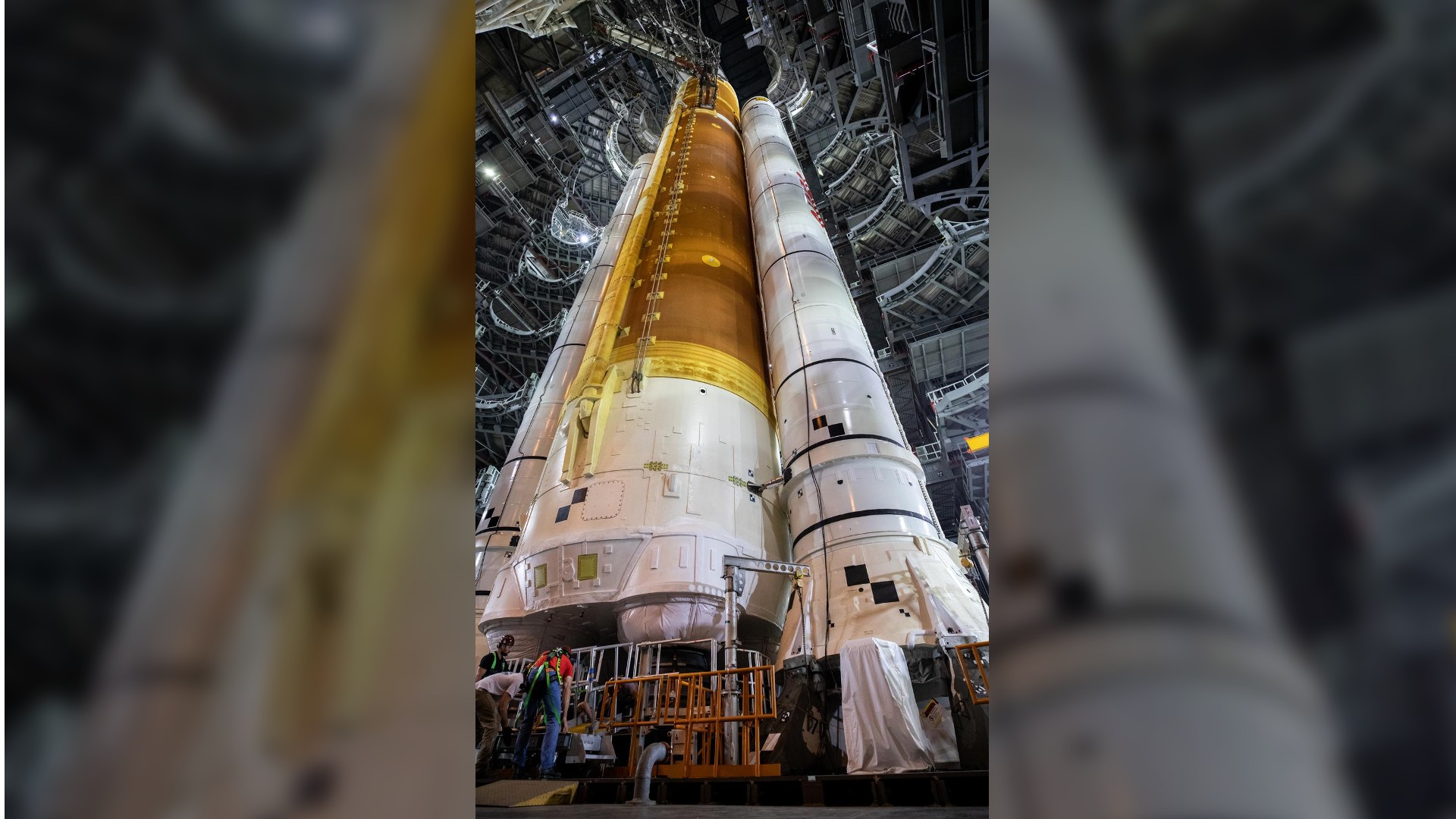
NASA's new mega moon rocket, the Space Launch System (SLS), is getting one step closer to reaching for the stars Wednesday (April 6) by completing what's known as a wet dress rehearsal, in which the agency loaded the vehicle's tanks with cryogenic fuel and simulated countdown in preparation for liftoff.
While NASA broadcasts live video of the test on its website, many key details about the event were kept secret, ostensibly for reasons having to do with national security. But do most of these details really need to be top secret? Here's what we know about the agency's decision to be so clandestine, and why not everybody is buying their stated rationales.
What is a wet dress rehearsal?
In anticipation of lighting up its gigantic new launch vehicle, which when capped by the Orion crew vehicle stands 322 feet (98 meters) tall, higher than the Statue of Liberty, NASA needs to test all of the SLS's various components. During the uncrewed wet dress rehearsal, the agency loads up the rocket's tanks with supercooled liquid hydrogen and liquid oxygen — which when combined produce a powerful thrust to send the vehicle into space — and practices various scenarios in preparation for liftoff.
"The test runs about two days long and emulates our launch countdown," said Charlie Blackwell-Thompson during a press briefing on Tuesday, March 29. Blackwell-Thompson is the launch director of NASA's Artemis program, which aims to eventually land the first woman and first person of color on the moon.
Engineers monitor temperatures and pressures in the tanks during the rehearsal, taking data the whole time that will help them once the rocket is ready for its debut flight. They also practice going through several different countdown sequences, once to T-minus 1 minute and 30 seconds, a second time down to 33 seconds before launch, and finally all the way down to T-minus 10 seconds before launch.
These allow launch controllers to simulate various situations in which a launch may have to be canceled — or "scrubbed" — due to a technical or weather-related issue, officials said during the March 29 briefing.
Why were key facts kept secret?
While NASA shared certain milestones about the wet dress rehearsal on social media, the agency was prohibited from discussing every detail due to concerns over International Traffic in Arms Regulations (ITAR), Tom Whitmeyer, the agency's associate administrator for common exploration systems development, told reporters during the press briefing.
Sign up for the Live Science daily newsletter now
Get the world’s most fascinating discoveries delivered straight to your inbox.
ITAR is a regulatory regime that restricts the sharing of information about weapons and technology in ways that may be harmful to U.S. national security or foreign policy, according to the U.S. Department of State.
"We're really super sensitive to cryogenic launch vehicles that are of this size and capability," Whitmeyer told reporters. "They are very analogous to ballistic-type capabilities that other countries are very interested in."
In particular, hostile foreign countries might like to get as much information as possible about things like "timing, sequence, flow rates, temperatures," he added. "Anything that would help them or other folks that could be used to do similar things," meaning building gigantic and potentially deadly missiles.
The complex interactions involved in loading up both the SLS's core rocket stage and its upper stage at the same time were a particular concern, Whitmeyer said. "How long it takes to do certain tasks — that's considered to be important information by other countries," he added. "So we have to be careful when we share data, particularly for the first time."
What are people saying about the concerns?
This is a typical example. NASA was forthcoming with detailed technical info on their programs back in the day. And the US did not somehow lose its lead in technology as a result! https://t.co/FqCko8uNlCMarch 29, 2022
The need to keep everything under wraps didn't sit well with some experts. "Sigh. ITAR has been the excuse for so much ridiculousness over the years," tweeted astronomer Jonathan McDowell of the Harvard-Smithsonian Center for Astrophysics, who follows space launches closely.
McDowell shared a detailed timeline that was given to reporters in 1992 in anticipation of the launch of the space shuttle Endeavor, suggesting NASA's current skittishness with regards to national security is a fairly recent phenomenon.
Reporter Michael Baylor, who works for NASASpaceflight.com, which focuses on space-related news, had even harsher words. "I am sorry, but this excuse is total BS. It is industry standard to broadcast the primary countdown loop. Pretty much all of the U.S. launch providers do it, and NASA did it during Shuttle. If you are worried about ITAR, you make the callout on a different loop," he tweeted.
Cryogenic fuels are not generally used much in ballistic missile systems, Baylor added. This is probably due to the fact that keeping fuel at supercooled temperatures for a long period of time is difficult and expensive, meaning that many countries have abandoned missiles that use such fuel, according to a website maintained by the Federation of American Scientists.
Now that the wet dress rehearsal is over, it's possible additional data will be shared during a post-test media teleconference on April 5, and NASA should be more forthcoming during the upcoming launch of the Artemis 1 mission, expected this summer, Whitmeyer said. "We're doing everything we can to provide as much information as possible."
Originally published on Live Science.

Adam Mann is a freelance journalist with over a decade of experience, specializing in astronomy and physics stories. He has a bachelor's degree in astrophysics from UC Berkeley. His work has appeared in the New Yorker, New York Times, National Geographic, Wall Street Journal, Wired, Nature, Science, and many other places. He lives in Oakland, California, where he enjoys riding his bike.









